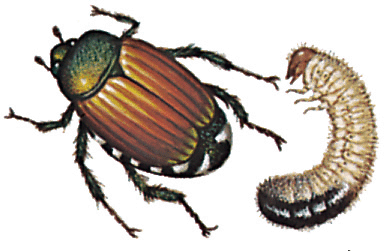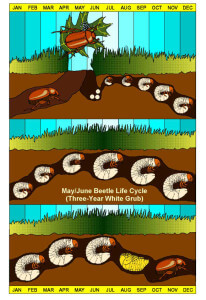What are Japanese beetles
The Japanese beetle is a plant pest native to Japan that attacks roots, foliage and fruit of a variety of host plants, including elm, maple, rose, zinnia, corn, asparagus, grape, apple, blueberries, raspberries and blackberries. The Japanese beetle larvae favour turf grass as their host material, while adults feed on the leaves and fruit of a wide variety of host plants.
How to identify the Japanese beetle

Distribution
In Canada, parts of southern Ontario and some isolated areas of Quebec have established populations. A mean summer soil temperature of 17.5 °C to 27.5 °C and a mean winter soil temperature of about – 9.4 °C as well as a uniform summer precipitation of 25 cm seem to govern the limits of its spread. The Niagara Peninsula and Hamilton-Wentworth region have been identified by Agriculture Canada to have resident beetle populations.
Damage caused by Japanese Beetle
This beetle is a serious pest. Adult beetles skeletonize foliage. While adults do not damage turf, they do feed on foliage and fruit of about 300 species of plants. Members of the rose family are preferred hosts as well as maple, birch, mountain ash, linden and fruit trees such as apples, cherries, peaches, plums,grapes and blueberries. Some plants such as geranium, castor bean and flowers of bottlebrush and buckeye cause paralysis and death of adults.
Larval feeding on the fibrous roots of grasses makes this stage a destructive pest for turf. Injured turf initially wilts and yellows during August and September. As the damage progresses, dead patches of turf can be observed. Often confused with drought stress, these affected areas can be lifted and pulled back to reveal the grubs beneath. Grubs will also feed on the roots of ornamentals and vegetables.
Life Cycle

While areas of turf and pasture are preferred locations for depositing eggs, they may also be laid in cultivated fields of rye, corn, beans, tomatoes or nursery stock, especially if adjacent grassy areas are dry and hard. Since moisture is crucial to egg hatch and larval development, during periods of deficient rainfall eggs may be laid in poorly drained ground, irrigated areas, or fallow fields where loose soil allows for the easy deposition of eggs. Egg laying continues until late July and August. Eggs hatch in about two weeks. Under dry conditions, eggs and larvae fail to develop. If there is adequate moisture, newly hatched grubs feed on fine roots in the upper 5-10 cm of soil. In drier or cultivated soils, grubs will be found lower in the soil profile.
In September, as soils begin to cool, grubs move deeper into the soil and remain where the soil is about 10oC at a depth of about 15-25 cm. In cultivated soils, this may be deeper, up to 25-30 cm. Lack of snow cover may increase larvae mortality. As soils warm in the spring, grubs move to the surface to feed for 3-4 weeks before pupating in late May and early June. Vertical distribution of grubs within the soil profile depends mostly on temperature and, to some degree, on moisture. Horizontal movement depends on the presence of fibrous roots.
Control
Unfortunately, the most effective way of getting rid of Japanese beetles is to hand pick them. It’s time consuming, but it works, especially if you are diligent. Organic, neem-based pesticides can also provide good control, as can insecticidal soaps. Note: Insecticidal soaps will kill the beetles, but don’t provide any ongoing protection to your plants. Or you may try putting down a drop cloth: In the early morning when they’re most active, shake them off and dump them into a bucket of soapy water. They will not survive
That being said, control strategies start by discouraging and preventing adult beetles from laying eggs. Since eggs are usually laid in grassy areas, clean cultivation may discourage egg laying. Clean cultivating soils may also help reduce populations by bringing eggs and grubs to the surface, exposing them to sun, wind and predators. Cultivating should coincide with grubs feeding close to the soil surface in early fall or late spring. Many weeds are hosts to adult Japanese beetles and grassy or weedy areas surrounding fields may act as potential breeding grounds for the pest. Maintaining good weed control will help eliminate potential food sources.
The use of entomogenous nematodes to treat the soil to help control grubs is being evaluated and may prove useful in the future. However, they will not become established and would have to be re-applied. Applying nematodes requires adequate moisture before and after application and soil temperatures of no less than 11°C. Nematodes may have potential in treating containers or rootballs. The cost may also be prohibitive.
Adjusting irrigation schedules to keep the soil conditions drier during egg laying, hatch and larval development may help to reduce populations.

Leave a Reply
You must be logged in to post a comment.